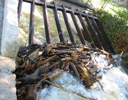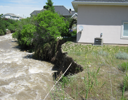Be Smart About Septic
Septic systems (also called onsite wastewater systems) are underground wastewater treatment structures used to treat household wastewater in areas without centralized sanitary sewer systems. A typical onsite system consists of a septic tank and a drainfield (or leachfield). Solids settle-out in the tank and liquid wastewater (effluent) flows to the drainfield where it percolates into the soil. The soil absorption process naturally removes harmful coliform bacteria, viruses, and nutrients.
If you have a septic system, it’s extremely important to keep up with its proper care and maintenance. This is especially true for streamside properties where proximity to the stream and potential for periodic flooding must be carefully considered. There are concerns with water quality anytime onsite wastewater systems are less than 150 feet from waterways, especially with regard to aging systems and those built before stricter regulations about drainfield sizing and placement were put into place.










